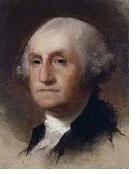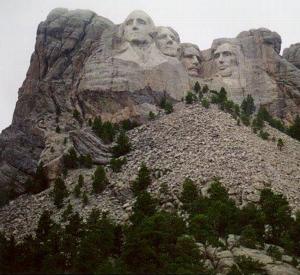 George Washington grew up on a landholding in Virginia, USA. He attended school irregularly but became familiar with tobacco growing and cattle raising and tought himself enough mathematics to know how to survey the fields.
George Washington grew up on a landholding in Virginia, USA. He attended school irregularly but became familiar with tobacco growing and cattle raising and tought himself enough mathematics to know how to survey the fields.General and first president of the USA, b. 22 (11*) February 1732 (Westmoreland County, Virginia), d. 14 December 1799 (Mt. Vernon, Virginia, USA).
 George Washington grew up on a landholding in Virginia, USA. He attended school irregularly but became familiar with tobacco growing and cattle raising and tought himself enough mathematics to know how to survey the fields.
George Washington grew up on a landholding in Virginia, USA. He attended school irregularly but became familiar with tobacco growing and cattle raising and tought himself enough mathematics to know how to survey the fields.
When George was eleven years old his father died and he came to live with his eldest half-brother Lawrence, who owned an estate inherited from John Washington, the first settler of the area. Lawrance increased his landholding through marriage with the daughter of William Fairfax, the cousin of Lord Fairfax, who had come into possession of over 5 million acres. George lived on Lawrence's new property called Mount Vernon.
In 1748 the 16 year old Washington entered employment, first with Lord Fairfax then with the local county council, as a surveyor and developed an intense interest in land speculation and westward settlement. When circumstances in 1751 placed him in control of Mount Vernon he increased the estate from 2,500 to 8,000 acres. By 1760 the number of slaves on the estate had risen from 18 to 49.
Washington's family had participated in military expeditions to drive the native Indian population off the land, and George Washington was also interested in a military career. In 1752, already in charge of Mount Vernon, he was appointed adjutant for southern Virginia. In 1753 he was sent as a messenger to warn French troops to stay out of the Ohio valley; he returned to report that the French were determined to advance. In the ensuing war Washington was made lieutenant colonel and soon promoted to colonel. In 1755, at the age of 23, he was appointed commander of all Virginian troops.
Washington's military decisions were not always wise, but he showed utmost personal determination even when seriously ill. By 1758 the French advance had been stopped, and Washington retired to his estate, which he increased in area and slaves through marriage to Martha Dandridge.
Washington was now one of the richest landowners of Virginia. He ran his estate scientifically and on the principle to "buy nothing you can make yourselves." The estate had a water mill, made its own bricks, had blacksmiths, carpenters, masons, coopers, weavers, a shoemaker and fishing master. But tools, paint, farming machinery and hardware had to be imported, and the trading restrictions imposed by the colonial masters in London were a constant irritation for Washington.
The decision of the British government in 1764 to raise revenue be taxing imports into the colonies created great agitation. Washington was not at the forefront of events but supported moves to reverse the situation. Only after the Boston Tea Party of 1773 did he rise to prominence, when he declared in a speech to the provincial convention that he would "raise one thousand men, subsist them at my own expense, and march myself at their head for the relief of Boston." Washington was elected a delegate to the first Continental Congress but again did not serve on any committee.
When war broke out with the colonial motherland in 1775 Washington was elected commander of all forces. Rivalry between troops from different states made his task difficult, and he spent much time enforcing discipline among an army that was ill-fed, lowly paid, often sick and continually saw as many men leave as new recruits arrive. He was not a great tactician, and his military efforts met with varied success; occasionally his troops were endangered through disobedience of commanders. He was rescued by the decision of France in 1778 to support the separation of the British colonies from the homeland. The war continued until 1783, but with French support Washington's campaign eventually achieved independence.
Having witnessed the entry of the American troops into New York in 1783 Washington resigned his commission and returned to farming on Mount Vernon. He watched the developing political chaos and disunity with growing concern and in 1787 participated in the federal convention as an ardent supporter of federalism. In 1789, again back in Mount Vernon, he reluctantly accepted the news of his unanimous election as first president of the United States of America.
In 1793 war broke out between England and France. Washington declared that the USA should remain "free from political connections with every other country, to see them independent of all, and under the influence of none. In a word, I want an American character that the powers of Europe may be convinced that we act for ourselves, and not for others." He therefore disregarded the treaty of alliance with France and maintained strict neutrality.
When the 4 years of his first term as president were completed Washington was elected for a second term and again accepted only reluctantly. In 1797 he resisted public calls for a third term and retired to Mount Vernon.
Washington was a member of the new colonial aristocracy of the settler society and as such a suitable candidate for leadership in the historical process of liberation from the motherland. He was not a gifted military leader and a reluctant political leader in peace time. But he was fortright, honest and just. He treated his employees and slaves well and did not seek personal advantage from public office - when he resigned after the war he submitted a statement of expenses to the government that did not even include a personal salary. It is his attitude to public service that makes him one of the great personalities of history. In the USA he is regarded a national hero, and he is one of four presidents carved into Mount Rushmore.
Nevins, A. (1995) George Washington, Encyclopaedia Britannica 15th ed.

Mount Rushmore National Memorial in South Dakota, USA.
The 20m high heads show the presidents (from left to right) George Washington, Thomas Jefferson, Theodore Roosevelt and Abraham Lincoln. Work on the monument began in 1927 and continued with many interruptions until 1941. The rubble below are the leftovers from the carving process.